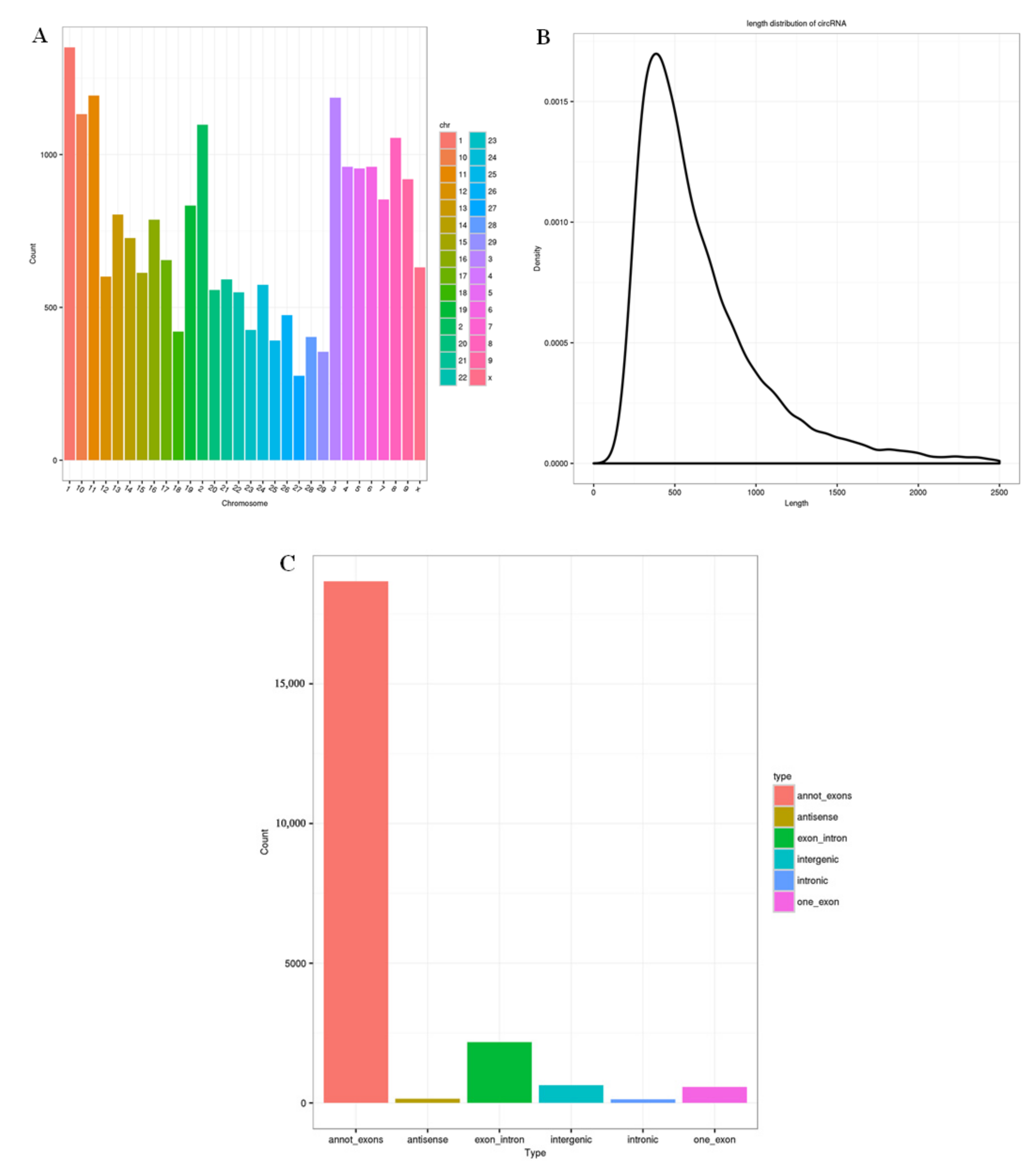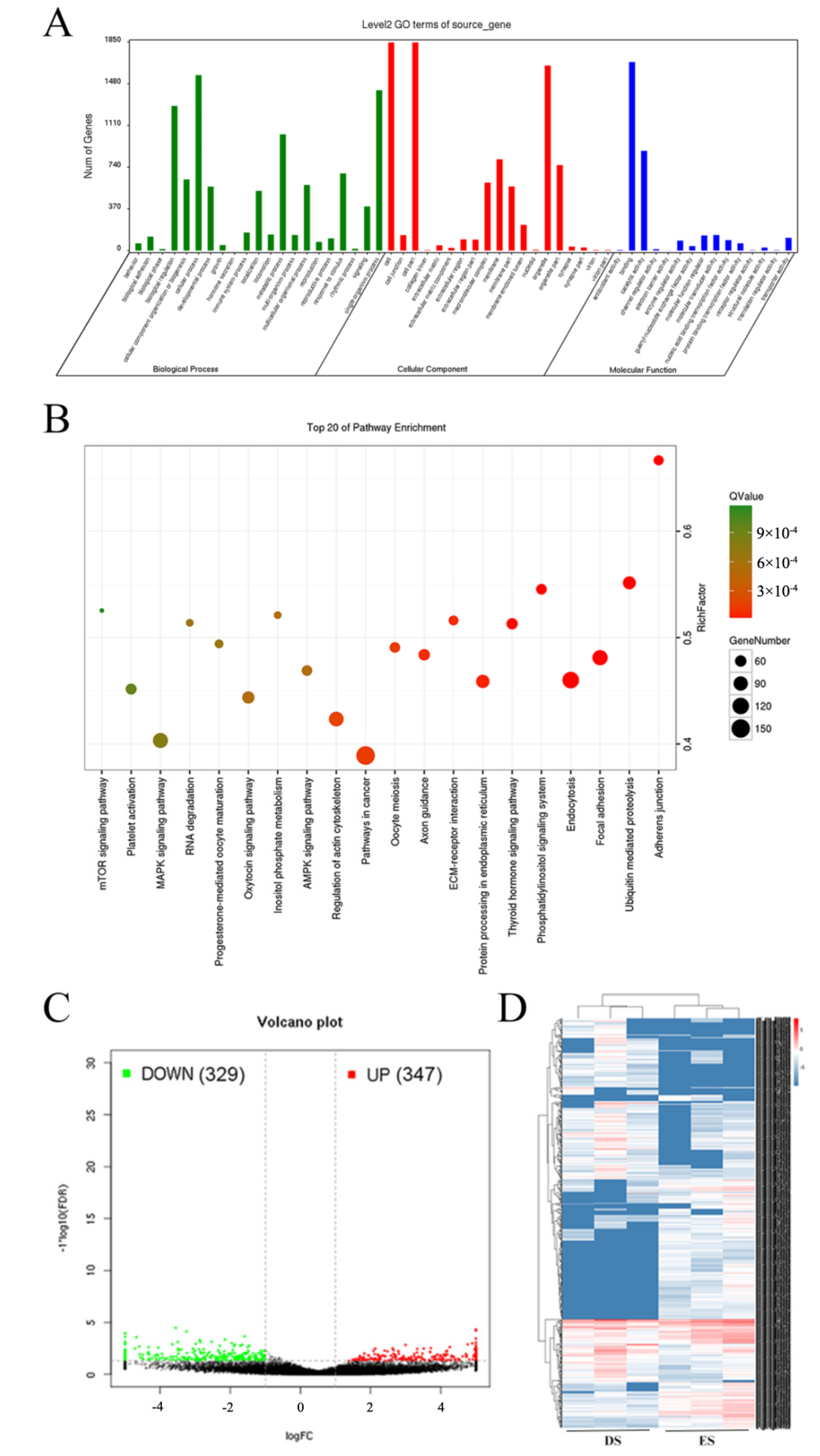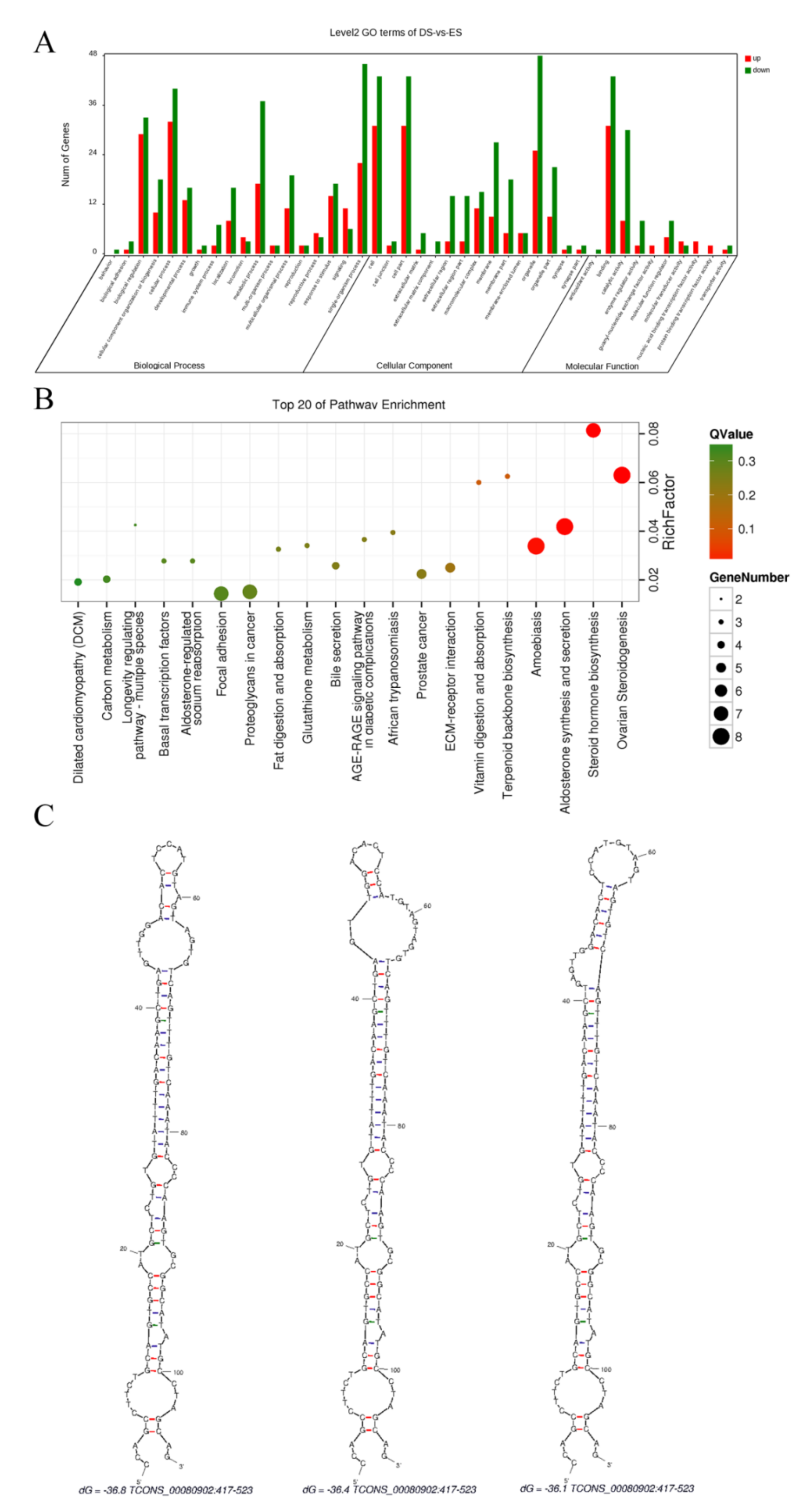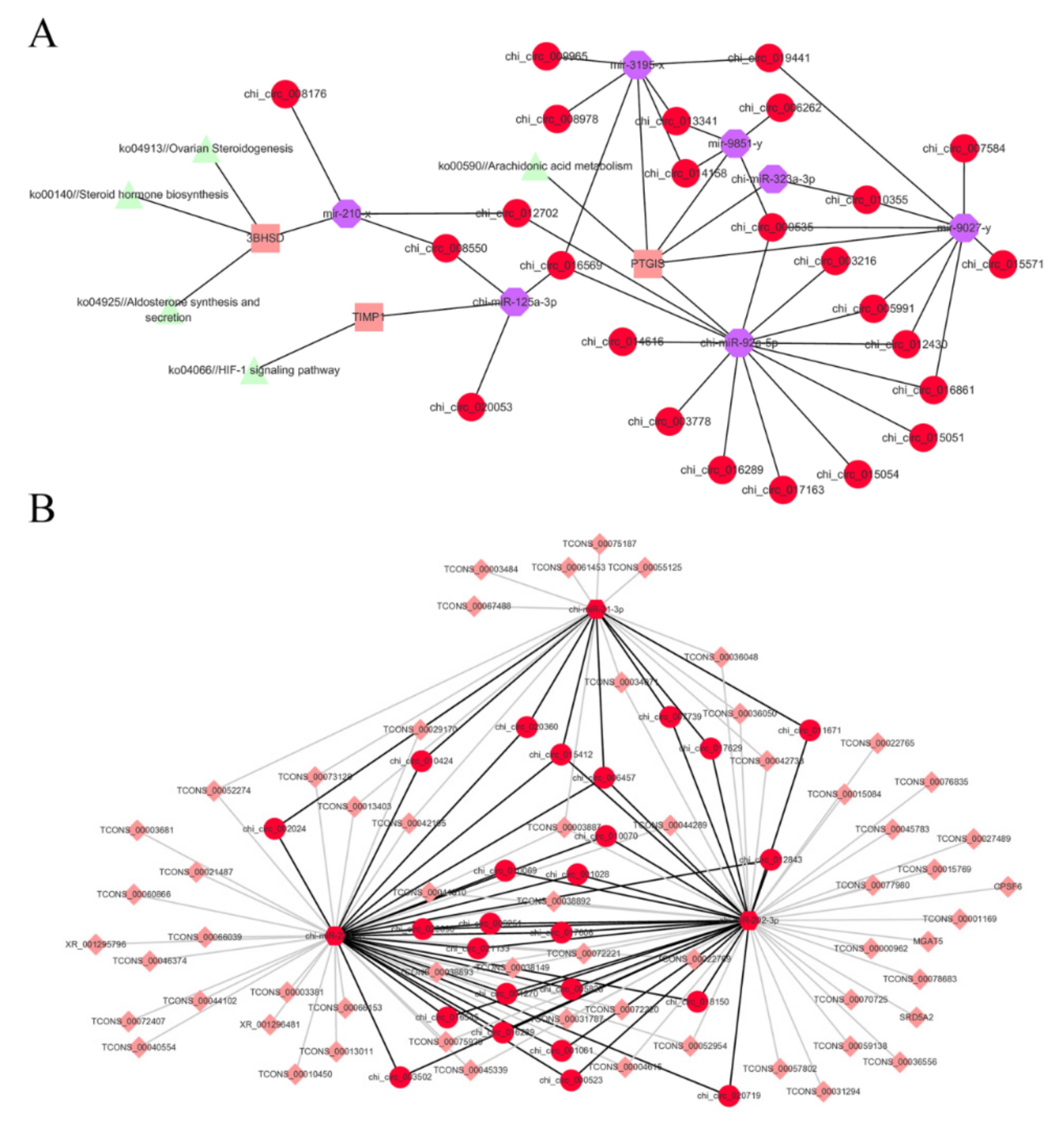Whole Transcriptome Analysis: Implication to Estrous Cycle Regulation
Abstract
Simple Summary
Abstract
1. Introduction
2. Methods
2.1. Animal and Ethics
2.2. miRNA Sequencing
2.3. circRNA Sequencing
2.4. mRNA and lncRNA Sequencing
3. Results
3.1. Overview of circRNA Sequencing
3.2. CircRNA Source Gene Analysis and Differentially Expressed circRNAs Analysis
3.3. Sequencing and Analysis of miRNA
3.4. Sequencing and Analysis of mRNA and lncRNA
3.5. Prediction of circRNA-miRNA-mRNA and miRNA-lncRNA Functional Regulatory Networks
4. Discussion
Supplementary Materials
Author Contributions
Funding
Institutional Review Board Statement
Informed Consent Statement
Data Availability Statement
Acknowledgments
Conflicts of Interest
Abbreviations
| ES | estrus stage |
| DS | diestrus stage |
| PCOS | polycystic ovary syndrome |
| miRNA | microRNA |
| circRNA | circular RNA |
| lncRNA | long non-coding RNA |
| mRNA | messenger RNA |
| MMP9 | matrix metallopeptidase 9 |
| TIMP1 | tissue inhibitors of metalloproteinases |
| 3BHSD | 3β-Hydroxysteroid dehydrogenase |
| PTGIS | Prostaglandin I2 Synthase |
| HQ | high quality |
References
- Gangestad, S.W.; Thornhill, R. Human oestrus. Proc. R. Soc. B Boil. Sci. 2008, 275, 991–1000. [Google Scholar] [CrossRef]
- Herbison, A.E. A simple model of estrous cycle negative and positive feedback regulation of GnRH secretion. Front. Neuroendocr. 2020, 57, 100837. [Google Scholar] [CrossRef] [PubMed]
- Mikhael, S.; Punjala-Patel, A.; Gavrilova-Jordan, L. Hypothalamic-Pituitary-Ovarian axis disorders impacting female fertility. Biomedicines 2019, 7, 5. [Google Scholar] [CrossRef] [PubMed]
- Zhang, Y.; Zhang, L.; Yu, C.-F.; Du, X.-Y.; Liu, X.-R.; Liu, J.-Z.; An, X.-P.; Wang, J.-G.; Song, Y.-X.; Li, G.; et al. Effects of interferon tau on endometrial epithelial cells in caprine in vitro. Gene Expr. Patterns 2017, 25-26, 142–148. [Google Scholar] [CrossRef] [PubMed]
- Fatet, A.; Pellicer-Rubio, M.-T.; Leboeuf, B. Reproductive cycle of goats. Anim. Reprod. Sci. 2011, 124, 211–219. [Google Scholar] [CrossRef] [PubMed]
- Armaiz-Pena, G.N.; Mangala, L.S.; Spannuth, W.A.; Lin, Y.G.; Jennings, N.B.; Nick, A.M.; Langley, R.R.; Schmandt, R.; Lutgendorf, S.K.; Cole, S.W.; et al. Estrous Cycle Modulates Ovarian Carcinoma Growth. Clin. Cancer Res. 2009, 15, 2971–2978. [Google Scholar] [CrossRef]
- Devall, A.J.; Santos, J.M.; Lovick, T.A. Estrous cycle stage influences on neuronal responsiveness to repeated anxiogenic stress in female rats. Behav. Brain Res. 2011, 225, 334–340. [Google Scholar] [CrossRef]
- Guimarães, R.A.; Asth, L.; Engelberth, R.C.; De Souza Cavalcante, J.; de Paula Soares-Rachetti, V.; Gavioli, E.C. Spontaneous failure of the estrous cycle induces anxiogenic-related behaviors in middle-aged female mice. Physiol. Behav. 2015, 147, 319–323. [Google Scholar] [CrossRef]
- Santos, V.R.; Kobayashi, I.; Hammack, R.; Danko, G.; Forcelli, P.A. Impact of strain, sex, and estrous cycle on gamma butyrolactone-evoked absence seizures in rats. Epilepsy Res. 2018, 147, 62–70. [Google Scholar] [CrossRef]
- Jaric, I.; Rocks, D.; Greally, J.M.; Suzuki, M.; Kundakovic, M. Chromatin organization in the female mouse brain fluctuates across the oestrous cycle. Nat. Commun. 2019, 10, 1–15. [Google Scholar] [CrossRef]
- Nascimento, E.B.D.; Dierschnabel, A.L.; Medeiros, A.D.M.; Suchecki, D.; Silva, R.H.; Ribeiro, A.M. Memory impairment induced by different types of prolonged stress is dependent on the phase of the estrous cycle in female rats. Horm. Behav. 2019, 115, 104563. [Google Scholar] [CrossRef]
- Tehrani, F.R.; Amiri, M. Polycystic Ovary Syndrome in Adolescents: Challenges in Diagnosis and Treatment. Int. J. Endocrinol. Metab. 2019, 17, e91554. [Google Scholar] [CrossRef]
- Chu, Q.; Zhou, B.; Xu, F.; Chen, R.; Shen, C.; Liang, T.; Li, Y.; Schinckel, A.P. Genome-wide differential mRNA expression profiles in follicles of two breeds and at two stages of estrus cycle of gilts. Sci. Rep. 2017, 7, 1–13. [Google Scholar] [CrossRef] [PubMed]
- Liu, Y.; Qi, B.; Xie, J.; Wu, X.; Ling, Y.; Cao, X.; Kong, F.; Xin, J.; Jiang, X.; Wu, Q.; et al. Filtered reproductive long non-coding RNAs by genome-wide analyses of goat ovary at different estrus periods. BMC Genom. 2018, 19, 1–13. [Google Scholar] [CrossRef]
- Toms, D.; Pan, B.; Li, J. Endocrine Regulation in the Ovary by MicroRNA during the Estrous Cycle. Front. Endocrinol. 2018, 8, 378. [Google Scholar] [CrossRef]
- An, X.; Zhang, Y.; Liu, J.; Ma, X.; Guo, Z.; Cao, B. NTS targeted by miR-182 modulates the apoptosis of goat endometrial epithelial cells. Acta. Vet. Beogr. 2019, 69, 340–347. [Google Scholar]
- Robles, V.; Valcarce, D.G.; Riesco, M.F. Non-coding RNA regulation in reproduction: Their potential use as biomarkers. Non-Coding RNA Res. 2019, 4, 54–62. [Google Scholar] [CrossRef] [PubMed]
- Ambros, V. The functions of animal microRNAs. Nature 2004, 431, 350–355. [Google Scholar] [CrossRef] [PubMed]
- Zhang, Y.; Liu, J.; Li, W.; Cao, F.; Niu, G.; Ji, S.; Du, X.; Cao, B.; An, X. A regulatory circuit orchestrated by novel-miR-3880 modulates mammary gland development. Front. Cell Dev. Biol. 2020, 8, 383. [Google Scholar] [CrossRef]
- Hansen, T.B.; Jensen, T.I.; Clausen, B.H.; Bramsen, J.B.; Finsen, B.; Damgaard, C.K.; Kjems, J. Natural RNA circles function as efficient microRNA sponges. Nat. Cell Biol. 2013, 495, 384–388. [Google Scholar] [CrossRef]
- Meng, X.; Li, X.; Zhang, P.; Wang, J.; Zhou, Y.; Chen, M. Circular RNA: An emerging key player in RNA world. Brief. Bioinform. 2016, 18, 545–557. [Google Scholar] [CrossRef] [PubMed]
- Vicens, Q.; Westhof, E. Biogenesis of Circular RNAs. Cell 2014, 159, 13–14. [Google Scholar] [CrossRef] [PubMed]
- Quinn, J.J.; Chang, H.Y. Unique features of long non-coding RNA biogenesis and function. Nat. Rev. Genet. 2016, 17, 47–62. [Google Scholar] [CrossRef] [PubMed]
- Ling, Y.; Quan, Q.; Xiang, H.; Zhu, L.; Chu, M.; Zhang, X.; Han, C. Expression profiles of differentially expressed genes affecting fecundity in goat ovarian tissues. Genet. Mol. Res. 2015, 14, 18743–18752. [Google Scholar] [CrossRef] [PubMed]
- Lu, T.; Zou, X.; Liu, G.; Deng, M.; Sun, B.; Guo, Y.; Liu, D.; Li, Y. A Preliminary Study on the Characteristics of microRNAs in Ovarian Stroma and Follicles of Chuanzhong Black Goat during Estrus. Genes 2020, 11, 970. [Google Scholar] [CrossRef]
- Tao, H.; Xiong, Q.; Zhang, F.; Zhang, N.; Liu, Y.; Suo, X.; Li, X.; Yang, Q.; Chen, M. Circular RNA profiling reveals chi_circ_0008219 function as microRNA sponges in pre-ovulatory ovarian follicles of goats (Capra hircus). Genomics 2017, 110, 257–266. [Google Scholar] [CrossRef] [PubMed]
- Lian, Z.; Zou, X.; Han, Y.; Deng, M.; Sun, B.; Guo, Y.; Zhou, L.; Liu, G.; Liu, D.; Li, Y. Role of mRNAs and long non-coding RNAs in regulating the litter size trait in Chuanzhong black goats. Reprod. Domest. Anim. 2020, 55, 486–495. [Google Scholar] [CrossRef]
- Hu, H.; Jia, Q.; Xi, J.; Zhou, B.; Li, Z. Integrated analysis of lncRNA, miRNA and mRNA reveals novel insights into the fertility regulation of large white sows. BMC Genom. 2020, 21, 1–15. [Google Scholar] [CrossRef]
- Zhao, W.; He, X.; Hoadley, K.A.; Parker, J.S.; Hayes, D.N.; Perou, C.M. Comparison of RNA-Seq by poly (A) capture, ribosomal RNA depletion, and DNA microarray for ex-pression profiling. BMC Genom. 2014, 15, 419. [Google Scholar] [CrossRef]
- Stilley, J.A.; Sharpe-Timms, K.L. TIMP1 Contributes to Ovarian Anomalies in Both an MMP-Dependent and -Independent Manner in a Rat Model1. Biol. Reprod. 2012, 86, 47. [Google Scholar] [CrossRef]
- Fujihara, M.; Yamamizu, K.; Wildt, D.; Songsasen, N. Expression pattern of matrix metalloproteinases changes during folliculogenesis in the cat ovary. Reprod. Domest. Anim. 2016, 51, 717–725. [Google Scholar] [CrossRef] [PubMed]
- Gomes, V.A.; Vieira, C.S.; Jacob-Ferreira, A.L.; Belo, V.A.; Soares, G.M.; Fernandes, J.B.F.; Ferriani, R.A.; Tanus-Santos, J.E. Imbalanced circulating matrix metalloproteinases in polycystic ovary syndrome. Mol. Cell. Biochem. 2011, 353, 251–257. [Google Scholar] [CrossRef] [PubMed]
- Rasmussen, M.K.; Ekstrand, B.; Zamaratskaia, G. Regulation of 3β-hydroxysteroid dehydrogenase/Δ⁵-Δ⁴ isomerase: A review. Int. J. Mol. Sci. 2013, 14, 17926–17942. [Google Scholar] [CrossRef]
- Teerds, K.J.; Dorrington, J.H. Immunohistochemical localization of 3 beta-hydroxysteroid dehydrogenase in the rat ovary during follicular development and atresia. Biol. Reprod. 1993, 49, 989–996. [Google Scholar] [CrossRef] [PubMed][Green Version]
- Dai, D.; Chen, B.; Feng, Y.; Wang, W.; Jiang, Y.; Huang, H.; Liu, J. Prognostic value of prostaglandin I2 synthase and its correlation with tumor-infiltrating immune cells in lung cancer, ovarian cancer, and gastric cancer. Aging 2020, 12, 9658–9685. [Google Scholar] [CrossRef] [PubMed]
- Armanini, D.; Bordin, L.; Donà, G.; Sabbadin, C.; Bakdounes, L.; Ragazzi, E.; Giorgino, F.L.; Fiore, C. Polycystic ovary syndrome: Implications of measurement of plasma aldosterone, renin activity and progesterone. Steroids 2012, 77, 655–658. [Google Scholar] [CrossRef] [PubMed]
- Li, S.; Qi, J.; Tao, Y.; Zhu, Q.; Huang, R.; Liao, Y.; Yue, J.; Liu, W.; Zhao, H.; Yin, H.; et al. Elevated levels of arachidonic acid metabolites in follicular fluid of PCOS patients. Reproduction 2020, 159, 159–169. [Google Scholar] [CrossRef]
- Lieske, P.L.; Wei, W.; Crowe, K.B.; Figueroa, B.; Zhang, L. HIF-1 Signaling Pathway Implicated in Phenotypic Instability in a Chinese Hamster Ovary Pro-duction Cell Line. Biotechnol. J. 2020, 15, e1900306. [Google Scholar] [CrossRef]
- Sabbadin, C.; Andrisani, A.; Ambrosini, G.; Bordin, L.; Donà, G.; Manso, J.; Ceccato, F.; Scaroni, C.; Armanini, D. Aldosterone in Gynecology and Its Involvement on the Risk of Hypertension in Pregnancy. Front. Endocrinol. 2019, 10, 575. [Google Scholar] [CrossRef]
- Ding, Q.; Jin, M.; Wang, Y.; Liu, J.; Kalds, P.; Wang, Y.; Yang, Y.; Wang, X.; Chen, Y. Transactivation of miR-202-5p by Steroidogenic Factor 1 (SF1) Induces Apoptosis in Goat Granu-losa Cells by Targeting TGFβR2. Cells 2020, 9, 445. [Google Scholar] [CrossRef]
- Fu, X.; He, Y.; Wang, X.; Peng, D.; Chen, X.; Li, X.; Wang, Q. Overexpression of miR-21 in stem cells improves ovarian structure and function in rats with chemo-therapy-induced ovarian damage by targeting PDCD4 and PTEN to inhibit granulosa cell apoptosis. Stem Cell Res. Ther. 2017, 8, 187. [Google Scholar] [CrossRef]
- Qin, L.; Chen, J.; Tang, L.; Zuo, T.; Chen, H.; Gao, R.; Xu, W. Significant Role of Dicer and miR-223 in Adipose Tissue of Polycystic Ovary Syndrome Patients. Biomed. Res. Int. 2019, 2019, 1–9. [Google Scholar] [CrossRef] [PubMed]
- Cammas, L.; Reinaud, P.; Bordas, N.; Dubois, O.; Germain, G.; Charpigny, G. Developmental regulation of prostacyclin synthase and prostacyclin receptors in the ovine uterus and conceptus during the peri-implantation period. Reproduction 2006, 131, 917–927. [Google Scholar] [CrossRef] [PubMed]
- Battersby, S.; Critchley, H.O.D.; De Brum-Fernandes, A.J.; Jabbour, H.N. Temporal expression and signalling of prostacyclin receptor in the human endometrium across the menstrual cycle. Reproduction 2004, 127, 79–86. [Google Scholar] [CrossRef] [PubMed][Green Version]
- Karakaya, C.; Guzeloglu-Kayisli, O.; Uyar, A.; Kallen, A.N.; Babayev, E.; Bozkurt, N.; Unsal, E.; Karabacak, O.; Seli, E. Poor ovarian response in women undergoing in vitro fertilization is associated with altered microRNA expression in cumulus cells. Fertil. Steril. 2015, 103, 1469–1476. [Google Scholar] [CrossRef] [PubMed]
- Gay, S.; Bugeon, J.; Bouchareb, A.; Henry, L.; Delahaye, C.; Legeai, F.; Montfort, J.; Le Cam, A.; Siegel, A.; Bobe, J.; et al. MiR-202 controls female fecundity by regulating medaka oogenesis. PLoS Genet. 2018, 14, e1007593. [Google Scholar] [CrossRef] [PubMed]
- Fang, G.; Liu, J.; Wang, Q.; Huang, X.; Yang, R.; Pang, Y.; Yang, M. MicroRNA-223-3p Regulates Ovarian Cancer Cell Proliferation and Invasion by Targeting SOX11 Expression. Int. J. Mol. Sci. 2017, 18, 1208. [Google Scholar] [CrossRef] [PubMed]
- Murri, M.; Insenser, M.; Fernández-Durán, E.; San-Millán, J.L.; Luque-Ramírez, M.; Escobar-Morreale, H.F. Non-targeted profiling of circulating microRNAs in women with polycystic ovary syndrome (PCOS): Effects of obesity and sex hormones. Metabolism 2018, 86, 49–60. [Google Scholar] [CrossRef]





Publisher’s Note: MDPI stays neutral with regard to jurisdictional claims in published maps and institutional affiliations. |
© 2021 by the authors. Licensee MDPI, Basel, Switzerland. This article is an open access article distributed under the terms and conditions of the Creative Commons Attribution (CC BY) license (https://creativecommons.org/licenses/by/4.0/).
Share and Cite
An, X.; Zhang, Y.; Li, F.; Wang, Z.; Yang, S.; Cao, B. Whole Transcriptome Analysis: Implication to Estrous Cycle Regulation. Biology 2021, 10, 464. https://doi.org/10.3390/biology10060464
An X, Zhang Y, Li F, Wang Z, Yang S, Cao B. Whole Transcriptome Analysis: Implication to Estrous Cycle Regulation. Biology. 2021; 10(6):464. https://doi.org/10.3390/biology10060464
Chicago/Turabian StyleAn, Xiaopeng, Yue Zhang, Fu Li, Zhanhang Wang, Shaohua Yang, and Binyun Cao. 2021. "Whole Transcriptome Analysis: Implication to Estrous Cycle Regulation" Biology 10, no. 6: 464. https://doi.org/10.3390/biology10060464
APA StyleAn, X., Zhang, Y., Li, F., Wang, Z., Yang, S., & Cao, B. (2021). Whole Transcriptome Analysis: Implication to Estrous Cycle Regulation. Biology, 10(6), 464. https://doi.org/10.3390/biology10060464





